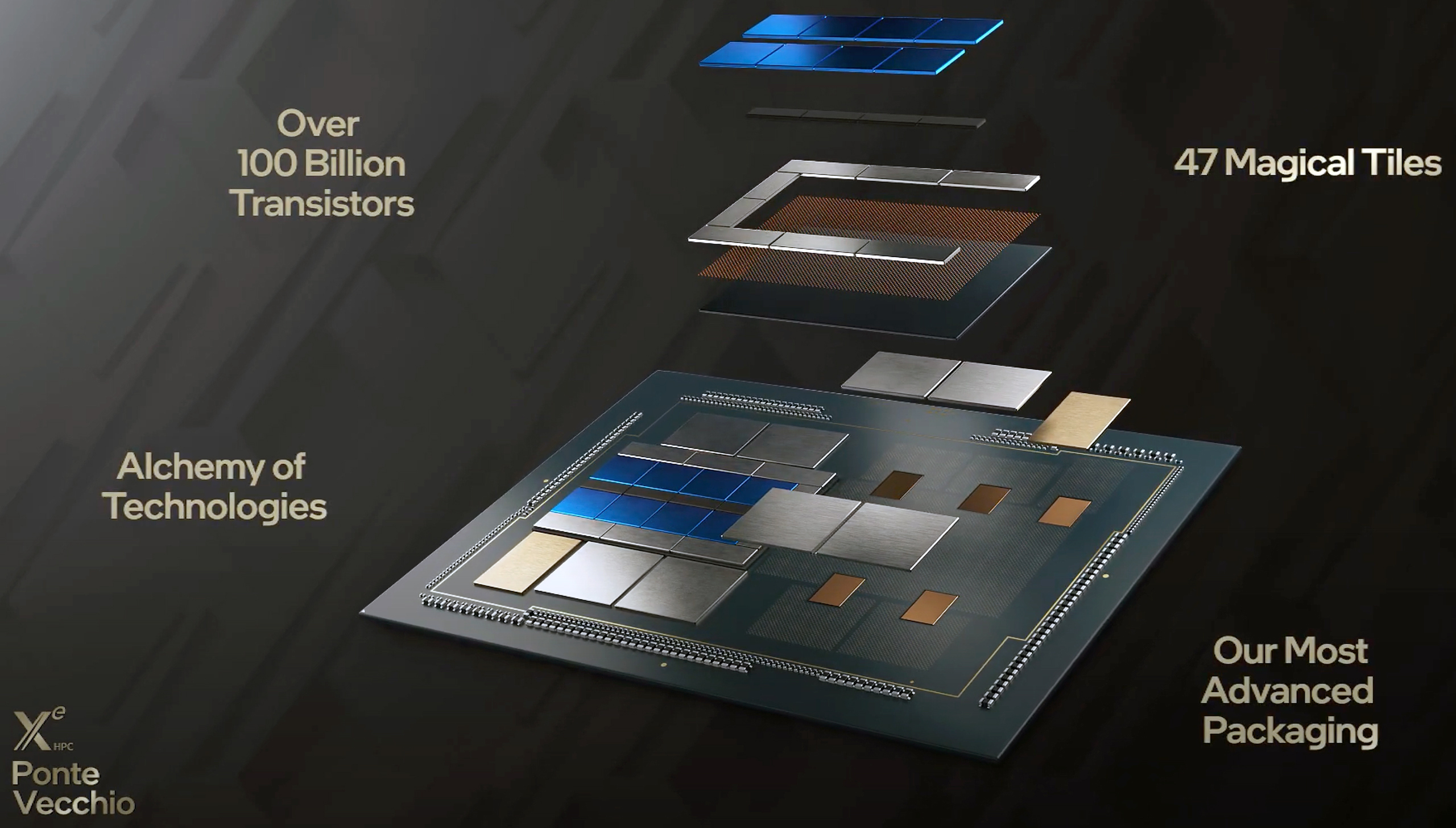Intel's Ponte Vecchio Xe-HPC GPU Boasts 100 Billion Transistors
Intel uploaded a detailed description of its upcoming Ponte Vecchio Xe-HPC GPU for supercomputers just hours after outlining its IDM 2.0 strategy that involves usage of internal and external manufacturing capabilities. Ponte Vecchio, which employs components produced by Intel, Samsung, and TSMC using a variety of process technologies, demonstrates Intel's vision of the future in the best way possible.
Intel's codenamed Ponte Vecchio is the company's first GPU based on the Xe-HPC microarchitecture that will be initially used for Argonne National Laboratory's Aurora supercomputer along with Intel's next-generation Xeon Scalable 'Sapphire Rapids' processor. The machine will be one of the industry's first supercomputers to feature over 1 ExaFLOPS FP64 performance.
Over time, the part will be available to other customers and Intel might even customize it as it is relatively easy to do given the fact that the Ponte Vecchio uses a disaggregated modular architecture, Intel's new approach to complex processors.
In fact, it would be impossible to build a monolithic Ponte Vecchio as it is a massive processor featuring 47 components, over 100 billion transistors, and offering PetaFLOPS-class AI performance (more on this later).
The Ponte Vecchio includes the following tiles/chiplets:
- 2 base tiles made using Intel's 10 nm SuperFin technology
- 16 compute tiles produced by TSMC initially and then by Intel when its 7 nm technology is ready for high-volume manufacturing (HVM).
- 8 Rambo cache tiles fabbed using Intel's 10 nm Enhanced SuperFin process
- 11 EMIB links made by Intel
- 2 Xe Link I/O tiles made by a foundry
- 8 HBM memory stacks produced by a DRAM manufacturer
At present, Intel only using its Ponte Vecchio Xe-HPC GPUs in the lab. While the modular design of the device allows the company to build it more or less cost efficiently, tailoring the design’s thermals, voltages, and frequencies is tricky and will take some time.

One interesting thing to note about Intel's Ponte Vecchio description is that the chipmaker said that it offers 'PetaFLOPS-class AI performance.' There are numerous AI workloads that require different compute precision.
Get Tom's Hardware's best news and in-depth reviews, straight to your inbox.
Intel usually considers FP16 to be the optimal precision for AI, so when the company says that that its Ponte Vecchio is a 'PetaFLOP scale AI computer in the palm of the hand,' this might mean that that the GPU features about 1 PFLOPS FP16 performance, or 1,000 TFLOPS FP16 performance. To put the number into context, Nvidia's A100 compute GPU provides about 312 TFLOPS FP16 performance.
Argonne National Laboratory's Aurora supercomputer is due in 2022.

Anton Shilov is a contributing writer at Tom’s Hardware. Over the past couple of decades, he has covered everything from CPUs and GPUs to supercomputers and from modern process technologies and latest fab tools to high-tech industry trends.
-
hotaru251 i'm sorry....did they seriously use "magical tiles" in presentation?Reply
these arent products for little kids <_< -
Neilbob Replyhotaru251 said:i'm sorry....did they seriously use "magical tiles" in presentation?
these arent products for little kids <_<
That made me wince slightly too. Are Intel channelling Apple now? -
Co BIY Replyhotaru251 said:i'm sorry....did they seriously use "magical tiles" in presentation?
Sounds better "chips our rivals make that we can't".
Agree sounds like a placeholder word that slipped past into the final draft. -
Chung Leong Replyhotaru251 said:i'm sorry....did they seriously use "magical tiles" in presentation?
these arent products for little kids <_<
Remember, the presentation is meant for members of the press. -
InvalidError That's some epic packaging-fu. When you have nearly infinite resources and want to stomp competition in the "if you have to ask the price, you can't afford it" market segment, you do what you gotta do.Reply -
spongiemaster You sure this picture goes with this article?Reply
That looks like the new cooler bundled with the i9-11900k. -
TerryLaze Replyspongiemaster said:You sure this picture goes with this article?
That looks like the new cooler bundled with the i9-11900k.this might mean that that the GPU features about 1 PFLOPS FP16 performance, or 1,000 TFLOPS FP16 performance. To put the number into context, Nvidia's A100 compute GPU provides about 312 TFLOPS FP16 performance.
If it really is 3 times this then it looks about right.
-
spongiemaster Reply
Way to miss the joke. It isn't 3 times that. That's eight A100's which is 2.5 PFLOPS.TerryLaze said:If it really is 3 times this then it looks about right.

